By Philip Joe Cauchi
Introduction: Wingers or lateral midfielders play a highly important role in any system of play. Their main aim is to create width in attack by stretching the opposition’s defence. However, there is mainly two ways which this can be accomplished. A winger might be instructed to play inside closer to the striker or remain wide and high. In the first version, the winger’s position pulls the opposition’s full back towards the inside and thus liberating space for the team’s full back or wing back to venture forward and create other possibilities for the team to play vertically.
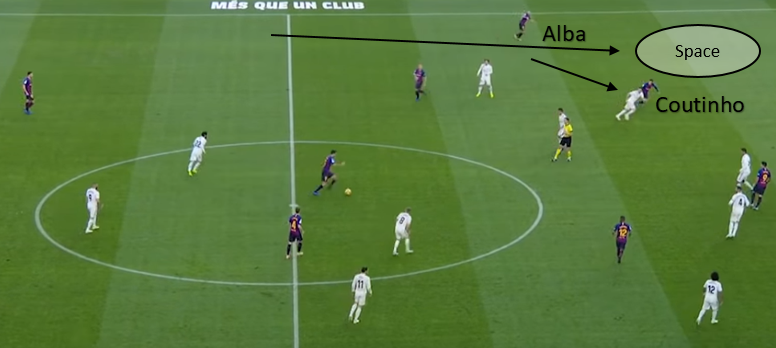
Figure 1 – FC Barcelona’ s wing forward Coutinho moves inside to create space for Alba, the wing back to overlap
In the latter version, the winger’s position aims to pull the opposition’s full back out of a solid defensive structure and create gaps in their defence.
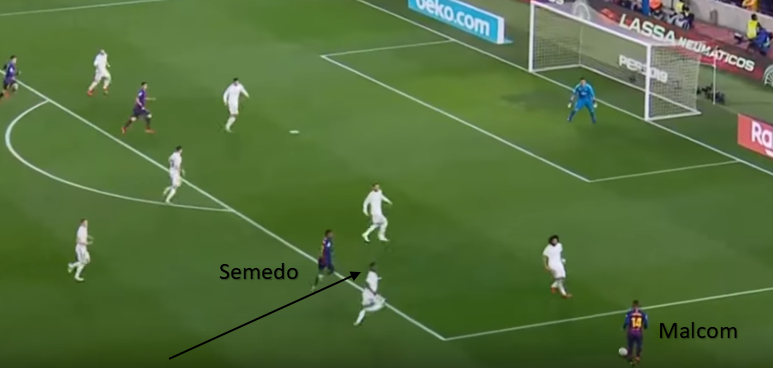
Figure 2 - FC Barcelona's wing forward Malcom stays wide thus creating the opportunity for wing back Semedo to cut inside
This space can be exploited by a midfielder inserting from a deeper position, or by an underlapping full back. Both versions require a high level of communication between the full back and the winger in order to understand each other’s movements. At a high level, teams are often unpredictable in their movements. This makes it even harder for the opponents to anticipate play with various players interchanging positions in search of space exploitation.
Coaching guidelines:
Please note that in this session we refer to a lateral midfielder instead of a winger as we are using a 1-4-2-3-1 system of play as our main point of reference. This is the first of two sessions regarding this subject. The following session should deal with enhancing the communication levels between the central midfielders, lateral midfielders and full backs. The third session should deal with integrating the central striker within movements involving the previously mentioned players, while the fourth and final session should also include the central defenders.
These sessions are just a guideline towards building successful links of communications between the different lines of the team. As coaches we can select a variation of the described training situations and/or maybe apply fewer activities than those shown within a training session as described in the articles. The sessions presented here are designed to be used with players who bear a wide base of technical-tactical knowledge. Further to this, it is taken into consideration that more than one coach takes part in the session, thus there is continuation from one activity to the next with minimal loss of time. What is described here occurs within a professional setting. Therefore, the training plan should be clearly understood between all coaches concerned.
If as coaches we are concerned with youth, amateur or semi-professional teams, we should take care of the limitations our players have. As an example if a coach is assigned with an under 15 team, the principles of the session may still apply. However, it is recommended to lower the number of players and/or complexity in certain activities.
Session No: 1 of 4.
Session title: Developing communication between wingers and full backs.
Total duration: 85 minutes.
Moment of play: Team in possession.
Team task: Attack build-up.
Theme: Utilising width during the build-up of an attack.
Main aim: Penetrate the opposition’s defence to create scoring chances.
Outcomes:
1. Staggered angles between the lateral midfielder and full back.
2. Overlapping and underlapping runs in search of penetration.
3. Tactical dribbling to pull the direct opponent out of a good defensive position.
4. Timing of movements to receive the ball or create space for teammate.
5. Timing of crosses and cut back passes.
6. Winger on the opposite side of where the ball is played attacks the second post.
7. Full back on the opposite side of where the ball is played covers inside.
Warm-up: 1v0 tactical dribbling warm-up.
Targeted outcome: 3.
Duration: 20 minutes.
Players: Groups of four or five players.
Area: 25 yards by 15 yards.
Description: Prior to this exercise the players perform various activation exercises that include running coordination, lateral running, back pedalling and side stepping. This should be followed with exercises that engage the core muscles. Every two minutes players perform dynamic stretches and mobility exercises.
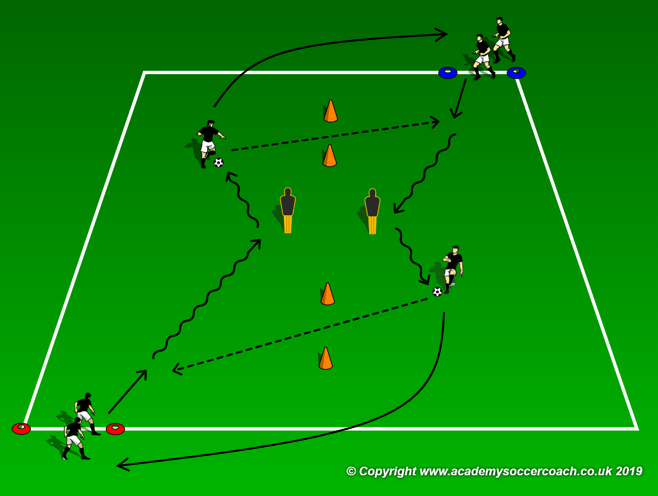
In this exercise players run with the ball, perform a feint at the mannequin prior to change speed and direction and pass the ball between the cones to the opposite side. The receiving player should attack the ball and not just wait for it. After passing, players join the end of the opposite line. During this specific warm-up, we aim to coach the players’ ability to receive the ball using a good first touch, while developing a positive mentality in dribbling the ball towards an opponent with the aim of pulling her out of a good defensive position to create the necessary space to attack.
Analytical training situation: Attack down the flank to finish with a cross.
Targeted outcomes: 1, 3, 5 and 6.
Duration: 10 minutes – 2 x 4 minutes interspersed with two minutes of rest.
Players: Attacking team (blacks) plays in a 1-3-2-3-1 formation and the defending team in a 1-4-2-3 formation.
Area: 60 yards in length by 50 yards in width.
Description: Play starts from the attacking team’s goalkeeper (blacks) who plays the ball to either midfielders (6 and 8) or central defender (4). The players at the mentioned positions may combine with each other or play directly to the lateral midfielder. The lateral midfielder starts from an advantageous position (from the blue marker), eight to ten meters in front of the opposition’s full back. The lateral midfielder aims to play a cross while being tracked by the opposition’s full back. If the opponents win the ball, they counter on the black team’s goal. When the ball goes out of play or a goal is scored, restart always takes place from the black team’s goalkeeper. Lateral midfielders and opposition’s full backs do not start until the ball is played to either lateral midfielder. In this practice we work on the open body stance of the lateral midfielders and the positioning of the ball-side full back when the lateral midfielder is in possession of the ball. This always has to be at an angle, either inside or wide towards the touch line, depending on the positioning of teammates and opponents.
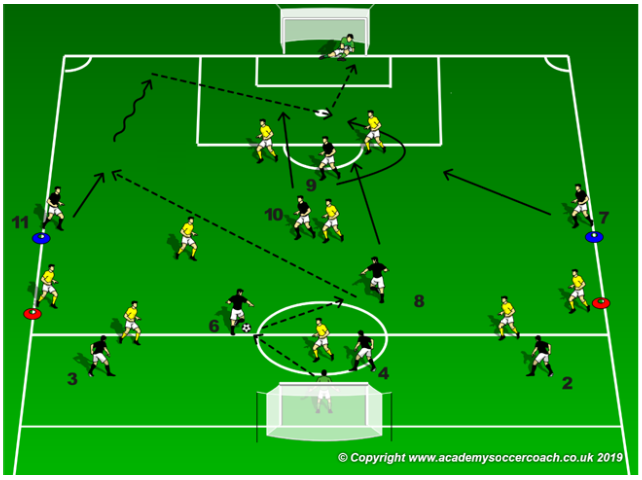
Global training situation: Attacking within vertical zones.
Targeted outcomes: All.
Duration: 10 minutes – 2 x 4 minutes interspersed with two minutes of rest.
Players: Attacking team (blacks) plays in a 1-3-2-3-1 formation and the defending team in a 1-4-1-1 formation.
Area: 60 yards in length by 50 yards in width.
Description: Play is 2v2 on each flank zone and 5v5 in the central zone. Players play in their natural position in the team. Focus is on the black (attacking) team. As such every restart takes place from the black team’s goalkeeper. All players must remain inside their assigned zone until the ball reaches either of the two flank zones. However, in the flank zone where the ball is, only the full backs and lateral midfielders of opposing teams are allowed to remain. The reason behind this is that we want to develop the cooperation between the full back and lateral midfielder to move in tandem with each other in order to create the necessary options to attack verticality. If the ball is played to either flank zone, the opposite flank’s lateral midfielder moves towards the centre to attack the far post while the full back moves towards the inside to cover. This is illustrated in the below diagram.
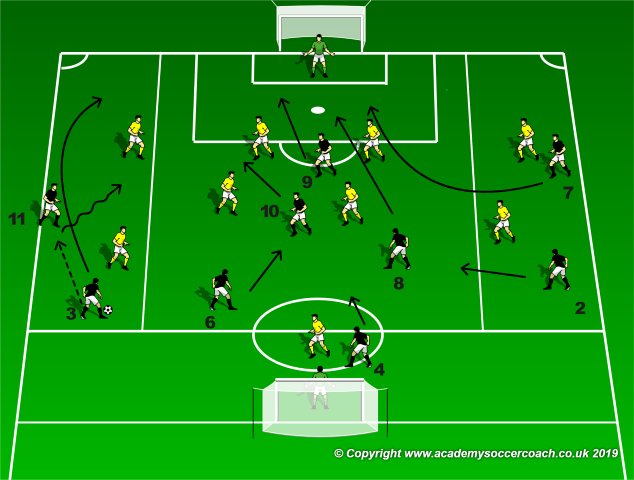
Analytical training situation: Attack verticality after switching play.
Targeted outcomes: All.
Duration: 15 minutes – 4 x 2 minutes interspersed with two minutes of rest.
Players: Working using the previous formations, players are positioned as shown in the diagram hereunder.
Area: 60 yards in length by 50 yards in width with two inner grids each measuring 15 yards by 12 yards zones as shown in the below diagram.
Description: Start in one of the two grids by playing a 4v3 rondo. After performing a minimum of five sequential passes, play must be switched to the opposite grid. Play can be switched directly (as shown in the diagram) or through either midfielder (8) or central defender (4). After the ball is switched, the defenders aim to win the ball. If the defenders win the ball they counter as normal. As coaches we want to coach the initial positions of both the full back and lateral midfielder prior to receiving the ball and also the on and off-the-ball movement of the two by moving at angles to each other. The below diagram shows how after the ball is played to the lateral midfielder (7), the full back (2) overlaps to provide both width and a possible option to play vertically behind the defence. Another possibility would be for the full back to go wide and high and the lateral midfielder to move inside at an angle diagonally behind the full back.
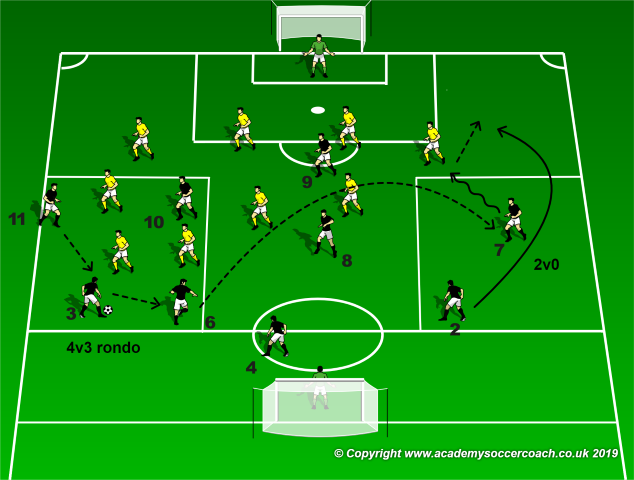
Global game: 10v10 including goalkeepers.
Targeted outcomes: All.
Duration: 20 minutes – 4 x 3 minutes interspersed with two minutes of rest.
Players: Attacking team (blacks) playing in a 1-3-2-3-1 formation and the defending team playing in a 1-4-1-1 formation.
Area: 60 yards in length by 50 yards in width.
Description: Normal match with regular soccer rules. It is now the time to analyse our work and see if the transfer of learning to the global game was successful or not. One thing to focus on is the initial positions of the two lateral players (full back and lateral midfielder) when the ball is in the middle or the opposite side of the field. Is one of them providing width while the other covers more to the inside? When the ball is played towards the flank, are the full back and lateral midfielder off-setting each other? Is there any mobility between the two; overlaps, underlaps, tactical dribbling, etc.? Another thing really worth taking notice of is the timing of the winger to attack the far post and the positioning of the full back to tuck further towards the inside to cover when the ball is played into the penalty area from the opposite flank.
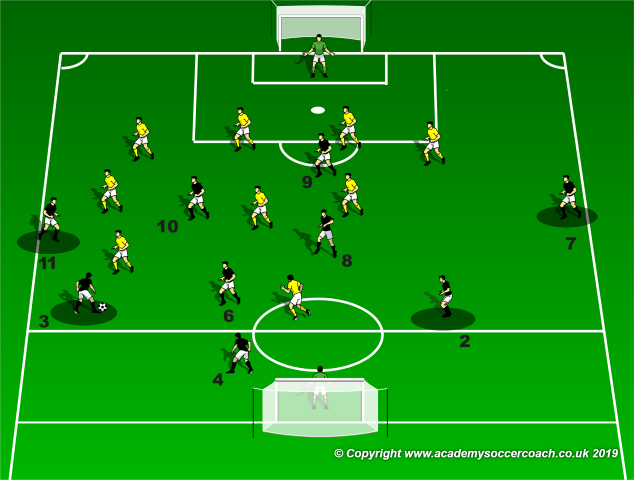
Conclusion: Passing and moving at angles.
Duration: 10 minutes.
Spend five minutes from the ten available on having the players grouped in threes while passing the ball and creating angles. The final five minutes should be spent on static stretching exercises.
Philip Joe Cauchi works as performance coach in Malta. He holds a UEFA A and a UEFA A Youth Elite coaching licences as well as a B.ed (Hons) in Education with Physical Education and is also a qualified football conditioning coach.


